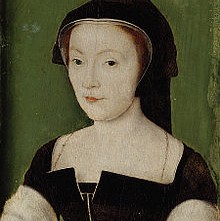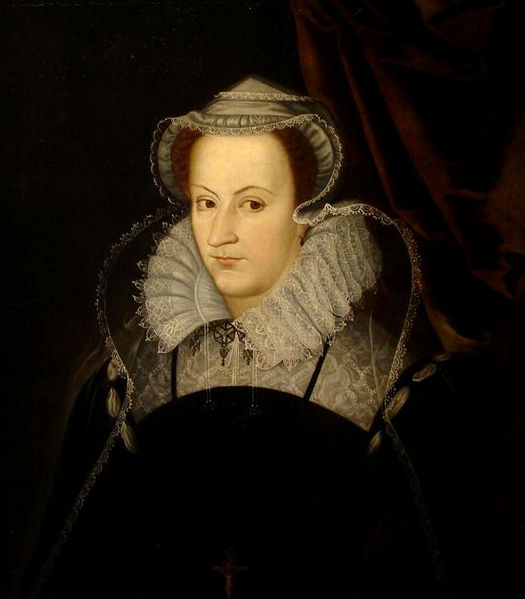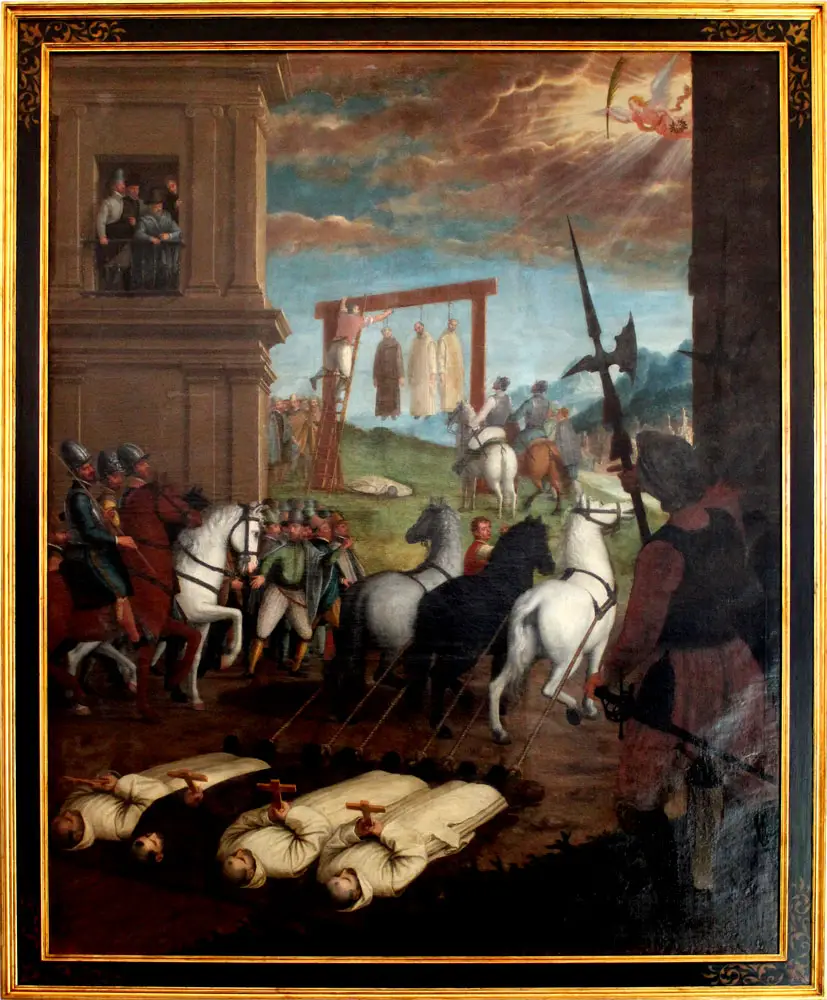7 May

Bishop John Fisher
1535 - John Fisher, former Bishop of Rochester, was visited by Thomas Cromwell, Master Secretary, and member of the King's Council. Cromwell read out the “Act of Supremacy” and Fisher refused to acknowledge the King as the supreme head of the Church, saying “The King owre Soveraign Lord is not supreme hedd yn erthe of the Cherche of Englande.” It is alleged that Richard Rich tricked him into saying those words, telling him that the King wished to know his real opinion in secret, but whatever the truth of the matter, Fisher was found guilty of treason and executed on 22nd July 1535.
1536 – Queen Anne Boleyn’s chaplain, William Latymer, was searched by the mayor and jurates of Sandwich on his arrival back in England. He was returning from a business visit to Flanders, a visit he had undertaken on behalf of the Queen. Latymer had often brought Anne religious books back from the Continent, so it was lucky for him that he did not have anything which could have been deemed as heretical in his luggage. Records were made of the books that he was carrying and of those which he was having sent directly to London, but he was allowed to carry on with his journey.
1540 – Death of Sir William Weston, Prior of the Hospital of St John of Jerusalem in England. He died at the priory on the day that the order to dissolve it was passed through the Commons. He was the uncle of Sir Francis Weston, a man executed in 1536 in the coup against Anne Boleyn.
1547 – Death of John Longland, Bishop of Lincoln, at Wooburn. He had requested that his body be buried at Eton College and his heart in the cathedral church at Lincoln.
1560 – English troops charged the wall of Leith at the siege of Leith. They were unsuccessful and suffered heavy losses.
1567 – Divorce of James Hepburn, 4th Earl of Bothwell, and Jean Gordon. The grounds for divorce were her alleged adultery with her servant, but Bothwell married Mary, Queen of Scots, just eight days later.
1592 – Death of Sir Christopher Wray, judge, Chief Justice of the King's Bench and Speaker of the House of Commons. He was buried at St Michael's Church, Glentworth, Lincolnshire.
1594 – Death of Edmund Scambler, Bishop of Peterborough and Norwich, at Norwich. He was buried in the cathedral, but his tomb was destroyed in the Civil War.
1603 – James VI/I arrived in London after travelling from Edinburgh to claim the English throne. His predecessor, Elizabeth I, had died on 24th March.
8 May
1508 – Birth of Charles Wriothesley, herald and chronicler, in London. His chronicle is one of the major primary sources for Henry VIII's reign. Charles came from a family of heralds; he was the younger son of Sir Thomas Wriothesley, Garter King of Arms, grandson of John Writhe, Garther King of Arms, and nephew of William Wriothesley, York Herald. Charles' offices included Rouge Croix Pursuivant and Windsor Herald of Arms in Ordinary, but he did not go as far as his father and grandfather.
1538 – Death of Edward Fox, Bishop of Hereford and diplomat. He was active in trying to secure the annulment of Henry VIII's marriage to Catherine of Aragon, and produced several books and polemics on Henry's Great Matter, including Henricus octavus.
1539 – The troops mustered between Whitechapel and Mile End marched through the City and Westminster to St James's, where Henry VIII reviewed them. This was in response to the war panic caused by Francis I and Charles V signing the Peace of Toledo.
1546 – Death of Thomas Knollys, President of Magdalen College, University of Oxford, from 1528 to 1536. In 1536, Knollys became Vicar of South Kirlby and died there in 1546. He was buried at Wakefield.
1559 – The “Act of Uniformity” was signed by Elizabeth I, and the “Act of Supremacy” was given royal assent. The monarch was Head of the Church again, and still is today.
9 May

Marie de Guise
1509 - The body of Henry VII was taken to St Paul's. Click here to read more.
1538 – Marie de Guise (Mary of Guise) and James V of Scotland were married by proxy at the Château de Châteaudun, with Robert Maxwell, 5th Lord Maxwell, standing in for James.
1558 – Death of Sir Philip Hoby, diplomat and administrator, at his home in Blackfriars, London. He had risen due to his friendship with Cromwell, and in Edward VI's reign, he was resident ambassador to the Emperor and a Privy Councillor.
1597 – Death of Thomas Hide, religious controversialist and writer of “A Consolatorie Epistle to the Afflicted Catholikes”. He fled into exile in Louvain in Elizabeth I's reign after he was labelled as a man who favoured the old religion. He then moved to Douai, where he died in 1597.
1657 – Death of William Bradford, founder of the Plymouth Colony, in Plymouth. He is also known for “Of Plimmoth Plantation”, his chronicle of the founding of the colony and its early years.
10 May
1509 – Birth of Edward Stanley, 3rd Earl of Derby and Privy Councillor to Mary I and Elizabeth I. He was born in Lancashire and was the eldest surviving son of Thomas Stanley, 2nd Earl of Derby, and his wife, Anne Hastings.
1533 – Opening of special court at Dunstable by Archbishop Cranmer to rule on the validity of the marriage of Henry VIII and Catherine of Aragon. On 23rd May, Cranmer’s court ruled that the marriage between Henry VIII and Catherine of Aragon was against the will of God, and declared that the marriage was null and void.
1536 - Giles Heron, foreman of the Grand Jury of Middlesex and son-in-law of the late Sir Thomas More, announced that the jury had decided that there was sufficient evidence to suggest that Anne Boleyn, George Boleyn, Mark Smeaton, Sir Henry Norris, Sir Francis Weston and Sir William Brereton were guilty of the alleged crimes carried out at Hampton Court Palace and Whitehall, and that they should be indicted and sent to trial before a jury.
1536 - Sir William Kingston, the Constable of the Tower of London, was ordered “to bring up the bodies of Sir Francis Weston, knt. Henry Noreys, esq.William Bryerton, esq. and Mark Smeton, gent. at Westminster, on Friday next after three weeks of Easter”, i.e. on 12th May. This would be the day of their trial.
1552 – Suicide of John Clerk, author and secretary to Thomas Howard, 3rd Duke of Norfolk, in the Tower of London. Clerk hanged himself with his girdle after books about necromancy were found in his possession, and he was interrogated regarding “lewd prophecies and slanders”.
1553 – The first expedition of the Company of Merchant Adventurers (Mystery and Company of Merchant Adventurers for the Discovery of Regions, Dominions, Islands, and Places unknown), led by Sir Hugh Willoughby, left London in search of a Northeast passage for Asia.
1554 – Death of Thomas Goodrich, Bishop of Ely and Lord Chancellor during the reign of Edward VI. He died at the palace of Somersham, Huntingdonshire, and was buried in Ely Cathedral. His tomb brass shows him in Protestant episcopal dress and with the Bible and Great Seal in his hands.
11 May

1509 – Henry VII was laid to rest next to his wife, Elizabeth of York, in Westminster Abbey. You can see pictures of their tomb and funeral effigies at http://westminster-abbey.org/our-history/royals/henry-vii-and-elizabeth-of-york
1532 – Henry VIII accused the clergy of being “scarce our subjects”, and attacked their oath to the Pope. Click here to read more.
1536 – The Grand Jury of Kent met in front of Chief Justice John Baldwin and six of his colleagues at Deptford. They met to rule on the alleged crimes committed at Greenwich Palace, East Greenwich, and Eltham Palace by Queen Anne Boleyn, Sir Henry Norris, Sir William Brereton, Sir Francis Weston, George Boleyn (Lord Rochford) and Mark Smeaton. It was ruled that the Queen and the five men would stand trial. See The Ruling of the Grand Jury of Kent and Queen Anne Boleyn's alleged crimes.
1537 - Blessed John Rochester and Blessed James Walworth, Carthusian monks from the London Charterhouse, were hanged in chains from the battlements of York. They had been tried in the city for treason for denying the King's supremacy following the Pilgrimage of Grace rebellion.
1560 – Death of Thomas Wendy, physician to Henry VIII and Queen Catherine Parr, at Haslingfield. According to martyrologist John Foxe, Wendy helped to save Catherine Parr from a plot against her. He also attended the dying King in January 1547.
1560 – Burial of John Falconer, physician and botanist, at St Stephen's Church, Coleman Street, London. Falconer. He is known as the first English person to have owned a herbarium.
1598 – Death of Edward Drew, lawyer, member of Parliament and Recorder of London, at Broad Clyst in Devon from gaol fever, which he had picked up working on the Northern Circuit. He was buried in Broad Clyst Parish Church.
1607 – Burial of Sir Edward Dyer, courtier and poet, at St Saviours, Southwark. With Philip Sidney and Fulke Greville, Dyer made up the “happy blessed Trinitie” that Sidney wrote of. His known works included the poems “The Songe in the Oke”, “The lowest trees have tops” and “He that his mirth hath lost”. He also dabbled in alchemy, studying under John Dee.
1610 – Death of Sir Henry Maynard, administrator. He was buried at St Mary the Virgin in Little Easton, Essex. Maynard served William Cecil, Lord Burghley, as his Chief Secretary and then, after Burghley's death, he became Secretary to Lord Admiral Nottingham.
12 May
1521 – Cardinal Wolsey announced the papal bull against Martin Luther in a ceremony outside St Paul's. Luther's books were then burned.
1536 - Mark Smeaton, Sir Henry Norris, Sir Francis Weston and Sir William Brereton were tried at a special commission of oyer and terminer, just a day after the Grand Jury of Kent had assembled, and only eight days after Weston and Brereton had been arrested. All four men were found guilty on all charges, declared traitors and sentenced to the usual traitor’s death, to be hanged, drawn and quartered at Tyburn. Click here to read more.
1536 - Thomas Howard, 3rd Duke of Norfolk, was appointed Lord High Steward of England in readiness for ruling, as Lord President, over the trials of Anne and George Boleyn. Click here to read more.
1537 – John Hussey, Baron Hussey, was charged with treason, for conspiring against Henry VIII and raising a rebellion against the King in Lincoln during the Pilgrimage of Grace. Hussey was executed in Lincoln on 29th June 1537.
1538 – John Forest, a Franciscan friar, refused to recant his allegiance to Rome.
13 May
1515 – Official marriage of Mary Tudor, Queen of France, and Charles Brandon, Duke of Suffolk, at Greenwich Palace, following their secret marriage in France. Click here to read more.
1536 – Queen Anne Boleyn’s royal household at Greenwich was broken up, even though she hadn't been tried yet. Click here to read more.
1568 – Mary, Queen of Scots's forces were defeated at the Battle of Langside.
1619 – Funeral of Anne (Anne of Denmark), consort of James VI and I. She was buried in Henry VII's Chapel in Westminster Abbey.





Leave a Reply